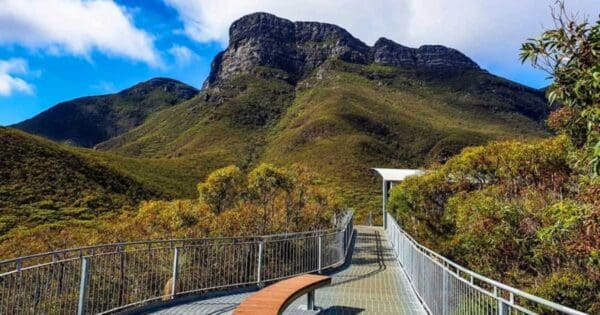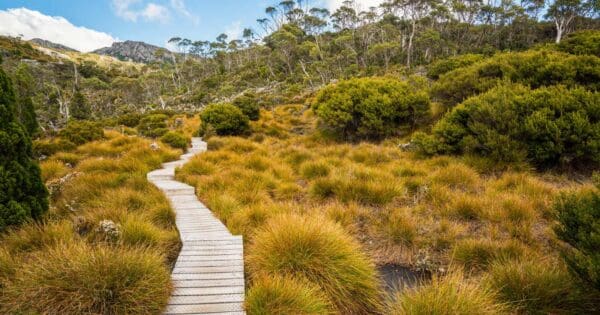How I found my tribe
I began my hiking journey as a solitary soul, relishing the solitude that solo hiking offered. Immersing myself in nature, setting my own pace and route, and enjoying the soundscape of nature were all part of the experience. Freedom was the hallmark of solo hiking, from starting my trek at sunrise to finishing long into the night if I chose.
Years ago, while vacationing in the Grampians National Park (Victoria) and exploring its numerous trails, I started seeking hikes closer to home. This was before this website existed, so searching online platforms was somewhat limited. Through a platform called Meetup, I stumbled upon a group called Geographically Challenged. At that time, both Meetup and bushwalking clubs were completely foreign concepts to me. Hesitantly, I joined the group to learn more.
One key reason for joining was the group’s focus on hikes I wanted to explore, including overnight and multi-day adventures that required more planning and effort. Since none of my friends shared my passion for hiking, and I valued safety in numbers, joining experienced individuals felt like a wise decision.
My first Meetup hike was the following weekend, and what an experience it was! While I cherished solo hiking, this was something entirely different. Sharing the passion and enthusiasm for the outdoors with others, and knowing exactly what the shared smiles on the summit meant, brought immense joy. I was instantly hooked.
Looking back, after several years and countless kilometers traversed, I reminisce on the incredible experiences, cherished memories, and amazing friends I’ve gained through joining those Meetup hiking groups all those years ago.

6 Reasons to join a hiking meetup and bushwalking club
1. Meet like-minded people
Hiking groups and bushwalking clubs are all about socialising with people who share your love for the outdoors. It’s a great way to meet new people and potentially forge lasting friendships ( I met my wife hiking). Even if you’re an introvert, most groups are welcoming and friendly, and you don’t have to be the life of the party to enjoy yourself. Plus, if you’re new to an area, it’s a fantastic way to find like-minded people to hang out with.
2. Streamlined logistics
Joining a group or bushwalking club can simplify the logistics of your next hike or walk. While individual preparation remains crucial, they often handle setting the route, timing, and location. Additionally, some groups offer guidance and information regarding the trail, potential challenges, and necessary gear. This allows you to focus on enjoying the experience while still being responsible for your own preparedness.
3. Safety in numbers
Hiking with a group is generally safer than going solo. Not only are you with other people, but the leaders are usually familiar with the trail and can help you navigate any challenges. They’ll also share their knowledge and experience, teaching you valuable tips about the trail, potential hazards, and proper preparation. Plus, with a group of experienced hikers, there’s always someone to learn from and ask questions.
4. Explore new places
Groups and clubs often explore trails you might not have found on your own. They can introduce you to new areas, breathtaking landscapes, and challenging paths you might not have attempted solo. It’s a great way to discover hidden gems and have new experiences you wouldn’t have had otherwise. Plus, you get to share these discoveries with the group, creating lasting memories.
5. Budget-friendly adventure
Hiking and bushwalking are inherently affordable activities. While you might need personal gear, transportation, and sometimes food and drinks for socialising afterwards, the overall cost is minimal compared to other hobbies. Unless, of course, you get bitten by the gear bug, like some of us!
6. Step outside your comfort zone
Don’t be afraid to try something new! Joining a hiking group or bushwalking is a great way to push yourself outside your comfort zone and explore the outdoors in a different way. The worst that happens is you realise the group isn’t quite your cup of tea. But the potential benefits – lifelong friendships, amazing experiences, and a deeper connection with nature – far outweigh any initial hesitation.

Want to join a hiking group and bushwalking club?
Joining a hiking group and bushwalking club is a fantastic way to explore the outdoors, meet new people who share your passion for nature, and enjoy guided walks in a safe and supportive environment. Here’s a comprehensive guide to help you navigate the options and find the perfect fit for you:
Exploring your meetup options
While I may be slightly biased as an organiser for the Trail Hiking Australia Meetup groups, I can assure you there are amazing Meetup groups located all over Australia. To get started, simply search for “hiking Meetups near me” on the Meetup website. Once you find some options, create a free Meetup account and explore the group descriptions. Look for groups that align with your interests and activity level, and don’t hesitate to join several groups if you find multiple appealing options! Joining a Meetup is usually straightforward, but some groups may ask you a few introductory questions or a small fee to cover administrative costs.
Joining a bushwalking club
If you’re specifically interested in joining a bushwalking club, the process is quite straightforward. Start by searching online for “bushwalking clubs near me” or exploring resources like the Bushwalking Australia website. Club websites typically list their upcoming walk programs and membership information. However, some clubs might not publish their full program due to privacy concerns. In such cases, contacting the club secretary directly for details would be helpful.
Finding the right fit
When choosing a group or club, distance isn’t always the most important factor. Many groups and clubs organise activities across their state or region, so don’t limit yourself solely to options in your immediate vicinity. To truly find the perfect fit, consider factors like the group’s experience level, the types of walks they offer (e.g., difficulty level, day trips vs. multi-day hikes), and the overall atmosphere. Don’t hesitate to contact the group organiser or club secretary to discuss your experience level, preferred walk styles, and any questions you may have. This open communication will help ensure the group or club aligns with your expectations and activity level.
Exploring your options: Meetups and bushwalking clubs
Whether you’re drawn to the casual atmosphere of a Meetup group or the more structured environment of a bushwalking club, both offer fantastic ways to explore the outdoors with like-minded individuals.
- Meeting up with fellow hikers: Meetup groups are a great way to find local hiking enthusiasts and participate in casual day hikes. Many groups cater to various experience levels, so you can find one that aligns with your abilities. Joining a Meetup is usually straightforward, and some groups may even offer introductory walks for newcomers. Remember, attending a few group events allows you to assess the dynamics, meet the members, and decide if the group aligns with your preferences.
- Joining a bushwalking club: Bushwalking clubs offer a more structured approach to hiking, with planned walk programs, regular meetings, and formalised membership processes. Most clubs welcome new members, often allowing them to participate in one or two walks before committing to full membership. This “trial run” period allows you to experience the club’s atmosphere, assess the difficulty level of their walks, and determine if it’s a good fit for you. Additionally, some clubs may organise specific trial walks to evaluate potential members’ fitness and suitability for their activities.
By exploring both options and taking advantage of trial walks or introductory events, you’ll be well-equipped to find the perfect hiking community that aligns with your interests and experience level.
Building connections
Once you’ve joined a group or club, actively participate in their walks and events. Regular attendance not only allows you to explore new trails and gain valuable experience but also helps you build relationships with other members. Remember, hikers and bushwalkers are generally friendly and welcoming. Don’t be shy to introduce yourself and start conversations with others. Soon, you’ll find yourself feeling comfortable and enjoying the camaraderie of your newfound hiking community.

Choosing wisely: Indicators of trustworthy hiking groups and clubs
While the majority of hiking groups and bushwalking clubs offer exceptional experiences and prioritise safety, it’s wise to be discerning when choosing a group. Here are some key factors to consider when evaluating a group or club:
Insurance and Risk Management: Bushwalking clubs often have insurance policies in place, such as public liability insurance and personal accident insurance. Meetup groups may not. This indicates their commitment to responsible practices and provides a measure of protection for members. Inquire about the group’s insurance coverage and their approach to risk management on hikes.
Established Leadership: Look for groups with experienced leaders who prioritise safe and enjoyable outings. Ideally, leaders should possess relevant certifications or extensive backcountry experience. Check the group’s website or directly inquire about the qualifications and experience of their leaders.
Clear Communication and Organisation: Well-organised groups should have clear communication channels, regular meetings (even if virtual), and well-defined processes for trip planning, leader selection, and emergency protocols. A transparent approach to information sharing is a positive sign.
Positive Member Experiences: If possible, read reviews or testimonials from other members. You can also reach out to current members to ask about their experiences within the group and get an honest evaluation of the group’s atmosphere and practices.
Additional considerations
Group Size and Dynamics: It’s crucial to remember that large group sizes can significantly impact the environment and potentially contradict the Leave No Trace principles, which emphasise minimising environmental impact. Land managers and Leave No Trace recommend a maximum of 16 hikers on any hike. While some groups may have large memberships, be mindful of the specific size of the hiking events they organise. I have witness some groups with over 30 people on the hike. Choose a group that aligns with your comfort level, experience, and commitment to responsible outdoor practices, prioritising groups that generally adhere to smaller group sizes on their hikes.
Membership Requirements: Reputable clubs often have membership processes that may involve screening and trial hikes. This can help ensure the safety and preparedness of all participants. While it may seem like an extra step, this can indicate that the club prioritises responsible practices.
Remember: It’s always okay to ask questions and gather information before joining a group or club. A trustworthy organisation will be transparent, welcoming, and focused on creating a positive and safe experience for all members.

Meetups and bushwalking clubs (A recap):
While both Meetups and bushwalking clubs offer fantastic ways to explore the outdoors with like-minded individuals, they cater to slightly different preferences and experiences.
- Meetups: These groups generally offer a more casual and social environment, often focusing on day hikes and fostering connections within the group. They may not have regular meetings or formal memberships.
- Bushwalking clubs: While offering a strong sense of community and social interaction, clubs typically provide a more structured setting with planned walk programs, regular meetings, and formalised membership processes. They might also have stricter requirements regarding safety and member suitability due to the nature of their activities.
Ultimately, the choice of joining a Meetup, a bushwalking club, or even both depends on your individual preferences and desired experience. Whether you seek a casual and social environment, a structured and organised approach, or a combination of both, there’s sure to be a perfect hiking community waiting to welcome you with open arms.






Escaping Your Comfort Zone is a great body positive hike group.
Dinalise Swart